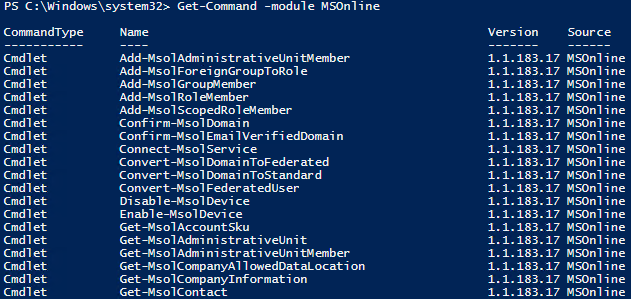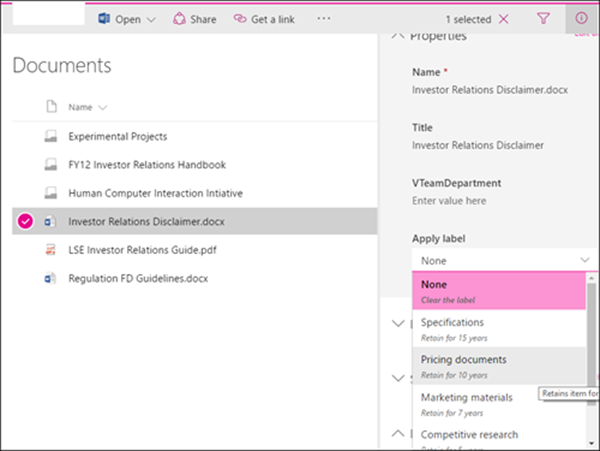38 office 365 labels powershell
Configuring default Office 365 Labels using PowerShell Office 365 labels are starting to get quite prolific across the stack now and I'm starting to see better uses for them over SharePoint Retention policies. If you're not familiar with Office 365 labels, my MVP colleague Joanne Klein has a great blog post from last year that provides a great overview of the experience that you can read here ... Manage Microsoft 365 Groups with PowerShell - Microsoft 365 ... May 12, 2022 · This article applies to both Microsoft 365 Enterprise and Office 365 Enterprise. This article provides the steps for doing common management tasks for Groups in Microsoft PowerShell. It also lists the PowerShell cmdlets for Groups. For info about managing SharePoint sites, see Manage SharePoint Online sites using PowerShell.
Guidlines for Creating and Publishing Record Labels in Office 365 Under the Solutions section click on Records Management (if you don't see this option click on Customize navigation below and add it to the navigation section). Click on either the File Plan tab link or " Manage your File Plan " Click on " + Create a label " and select Retention label. Enter the Top-Level information on your label:
Office 365 labels powershell
Get-Label (ExchangePowerShell) | Microsoft Docs PowerShell Get-Label -Identity "Engineering Group" | Format-List This example returns detailed information for the sensitivity label named Engineering Group. Parameters -Identity The Identity parameter specifies the sensitivity label that you want to view. You can use any value that uniquely identifies the label. For example: Name Using Office 365 Retention Policy – TheITBros Jun 08, 2022 · Microsoft (Office 365) retention policies make it easy for the user and administrator to clean up and archive items in a user’s mailbox on Exchange Online. Retention policies allow to automatically assign some trigger action for an item after a certain period (for instance, move the item to the archive mailbox or delete it permanently). How to Label Sites in Microsoft 365 - Netwrix To apply sensitivity labels to sites programmatically using PowerShell, take these steps: Step 1. Connect to the SharePoint Online tenant using an administrator account: Connect-SPOService -Url ' '. Step 2. Connect to the Security and Compliance Center using an administrator account:
Office 365 labels powershell. Manage sensitivity labels in Office apps - Microsoft Purview ... Jun 14, 2022 · External users can also use a Microsoft account to open encrypted documents when they use Windows and Microsoft 365 Apps (formerly Office 365 apps) or the standalone edition of Office 2019. More recently supported for other platforms, Microsoft accounts are also supported for opening encrypted documents on macOS (Microsoft 365 Apps, version 16 ... Removing the License for an Office 365 Feature with PowerShell Aug 21, 2018 · Fortunately, you can use PowerShell to remove licenses for sub-features bundled into an Office 365 plan like Teams, Forms, To-Do, or Stream. PowerShell License Management Office 365 Retention Policies and Labels - SysKit Jun 08, 2021 · Office 365 Retention Policies and Labels. Published: June 8, 2021; Published in: Office 365 & SharePoint Online; Author: Bojan Grubic; In Microsoft 365, we use retention and sensitivity labels to define who has access to what content and how long we need to keep it. Both are applied to resources using label policies. Office 365: Classification and Retention Labels - M365 Mike To create an Office 365 label, following these steps: Open Security and Compliance Centre; Click on Classifications; Click on Labels; The label will require configuration including: name your label ( Name ), add a description for the admins ( Description for Admins ), add a description for the users ( Description for Users); Click Next once the ...
How to Delete an Office 365 Group using PowerShell? Apr 21, 2018 · Here is how to permanently remove Office 365 Group using PowerShell: Assuming you have Office 365 global admin permissions, Open Windows PowerShell as Administrator. Connect to Azure AD by typing Connect-AzureAD cmdlet. Using Office 365 Sensitivity Labels - Petri IT Knowledgebase You'll find two types of labels here: sensitivity and retention, the latter being used to assign retention periods to Office 365 content. These labels were originally called classification labels,... Apply O365 labels to list items using powershell list all the columns separated with comma $fields = "id","title,uniqueid" $listitems = get-pnplistitem -list $list -fields $fields foreach($listitem in $listitems) { if ($listitem["title"] -eq $itemstorestore.title) { write-host "apply label to " $listitem["title"] "with guid - " $listitem["uniqueid"] $listitem.setcomplaincetag("correct … Apply sensitivity labels using PowerShell - Microsoft Tech Community There is no cmdlet to apply labels to individual files, afaik. Set-AIPFileLabel only works on local files. Using the MIP SDK is probably the way to go, at least until Microsoft introduces a cmdlet/Graph API endpoints.
Demystifying Labels in Office 365 - Joanne C Klein These labels are used to apply protection, rights management, and/or visual markings to an email or document. Examples of this include: apply a watermark, header, or footer to a document based on the label encrypt a document based on the label Create Sensitivity Labels and Policies using PowerShell Firstly, we need to install the Exchange Online PowerShell module. It is completed by installing and then importing the module using the following commands: 1. 2. Install-Module ExchangeOnlineManagement. Import-Module ExchangeOnlineManagement. Next, you can sign in to the Security and Compliance components using the command " Connect ... Manage Retention Policy and Tags by using PowerShell | Office 365 ... Reviewing Exchange Online management tasks of - Retention Policy and Tags setting in Office 365 environment using PowerShell cmdlets. 1.. Assign Retention Policy and Tags to a specific mailbox or to all mailboxes (bulk mode). 2. Display information about Retention Policy and Tags settings of a specific mailbox or, all existing mailboxes. 3. Remove Retention Policy and Tags option from a ... How to configue advanced settings of sensitive labelpolicy with powershell Set-LabelPolicy -Identity "Policy Name" -AdvancedSettings @ {HideBarByDefault="False"} # Set a separate label as default for just Outlook and keep the other default for rest of the application. Set-LabelPolicy -Identity "Policy Name" -AdvancedSettings @ {OutlookDefaultLabel="f6eda0a9-61e2-4f48-be69-d6cba1328015"}
Create and publish retention labels by using PowerShell - Microsoft ... PowerShell script Steps: Import and publish retention labels - Load retention labels csv file - Validate csv file input - Create retention labels - Create retention policies - Publish retention labels for the policies - Generate the log for retention labels and policies creation

Office 365 Retention Policy - Office 365 Retention Policy: 3 Things You Need to Know! : The ...
Get sensitivity labels using PowerShell script The Get-Label command will list out all sensitivity labels from the tenant. This line generates the formatted output: Get-Label |Format-Table -Property DisplayName, Name, Guid; Once we execute the above script successfully, we can see all the published sensitivity labels from the tenant.
Discovering API's for Sensitivity Labels in Microsoft 365 The Get-Label cmdlet is part of the Security & Compliance Center PowerShell cmdlets, and require correct permissions set in the Security and Compliance Admin Center. In essence, you connect to the PowerShell cmdlets and then you can use the Get-Label cmdlet to fetch all Labels (or a specific Label) in the organization: Get-Label
Azure Information Protection (AIP) - Part One - PowerShell Geek One of the lesser known PowerShell modules and Office 365 connection points is the Azure Information Protections (AIP) Service. Azure Information Protection (AIP) provides a method for encrypting items in transit (Exchange Online emails) or stored in the service (One Drive and SharePoint for examples).
Apply retention labels to files in SharePoint or OneDrive Apply a label in OneDrive or SharePoint. Select the item. In the upper-right corner, select Open the details pane. Under Apply label, select Choose a label to open the list of options. Select the appropriate retention label for your document. (To learn about the differences between the labels, you can point at each one to see a description of ...
Restructuring Office 365 Sensitivity Labels - Petri IT Knowledgebase Use the Get-UnifiedGroup cmdlet to find the set of groups assigned sensitivity labels. Compare the existing label that's assigned to each group and select the most appropriate label from the set...
Office 365 Retention Labels » ADMIN Magazine To create a retention label, go to Classifications | Labels in OSCC and click on the Create a label button. In the panel that appears, enter a unique and meaningful name for the new retention label. You can then also enter one description for administrators and another for users. Click Next (the list on the left is apparently only for navigation).
Office 365 Sensitivity Labels - SysKit Office 365 Sensitivity Labels Sensitivity labels enable us to classify and protect sensitive data within the file and the file itself. It will stay persistent with that file regardless of the file location. This way, users can continue to collaborate and let the sensitivity label worry about the protection.

SharePoint Online Adopts OneDrive’s Deletion Method for Items with Retention Labels - Office 365 ...
Control restricted content with Office 365 sensitivity labels How to use PowerShell to work with Office 365 sensitivity labels The compliance center cannot run all the available sensitivity label functionality. Admins must use PowerShell to adjust some configurations, such as the sharing controls for documents in SharePoint and OneDrive.
Auditing Retention Labels in Office 365 - Joanne C Klein It's comprised of 7 individual reports: 1 - How labels were applied. Either manually or auto-applied. 2 - the percentage of labels classified as records and non-records 3 - the top 5 labels in your tenant for usage 4 - who the top users are applying the labels (I'm in a tenant of one so only 1 user!)

Use sensitivity labels with Microsoft Teams, Office 365 groups, and SharePoint sites (public ...
Using Office 365 Sensitivity Labels with Teams, Groups, and Sites - Petri For now, you can use PowerShell to search for non-labelled groups and assign a default label. The Set-UnifiedGroup and Set-SPOSite cmdlets both support assigning labels today, and the Set-Team...

Using the Edge browser to read PDFs protected by Office 365 Sensitivity Labels - Office 365 for ...
Top Office 365 PowerShell Scripts and How to Use Them Top 5 Office 365 PowerShell Scripts Here are the top 5 most popular scripting solutions to help you manage your Microsoft 365 environment. 1. Use the PnP Provisioning Engine with the PnP PowerShell module. PnP PowerShell module is an open-source community-driven effort with many contributions from MCM/MVP Erwin van Hunan.
Top 50 PowerShell Scripts for Microsoft 365 Admins - Office 365 Reports Password report- Lists all users and their last password change time, password expiry date, etc. Admin report- Exports detailed report on Office 365 admins and their roles. Manager report- Gets Office 365 users and their manager details and helps to identify users without a manager. User logon history- Helps to track Office 365 users ...
microsoft-365-docs/bulk-create-publish-labels-using-powershell ... - GitHub The recommended method to create retention labels at scale is by using file planfrom the Microsoft Purview compliance portal. However, you can also use PowerShell. Use the information, template files and examples, and script in this article to help you bulk-create retention labels and publish them in retention label policies.








Post a Comment for "38 office 365 labels powershell"